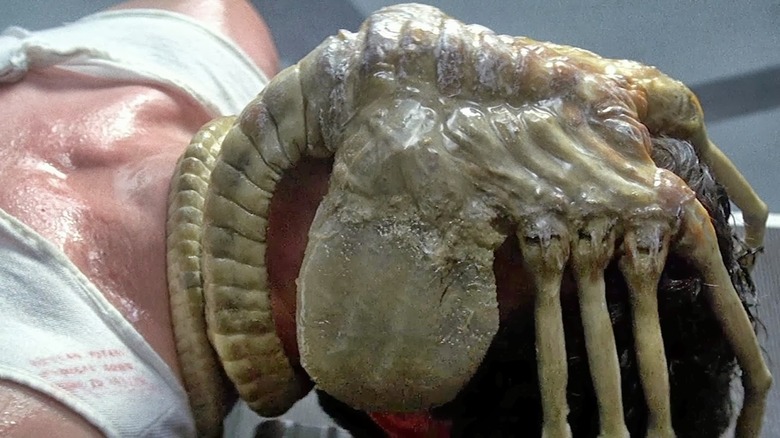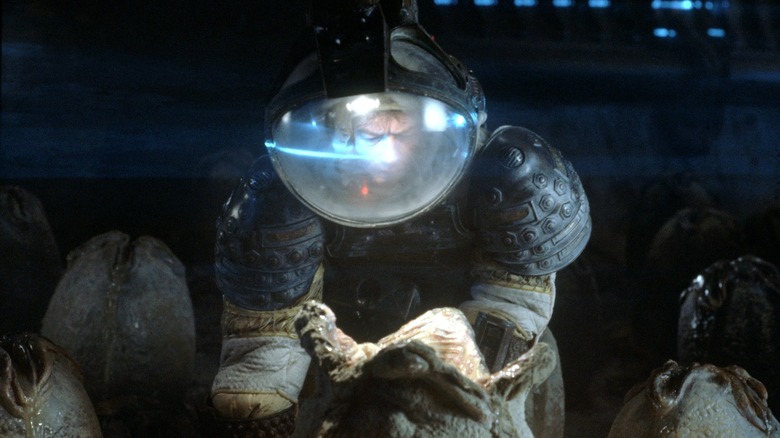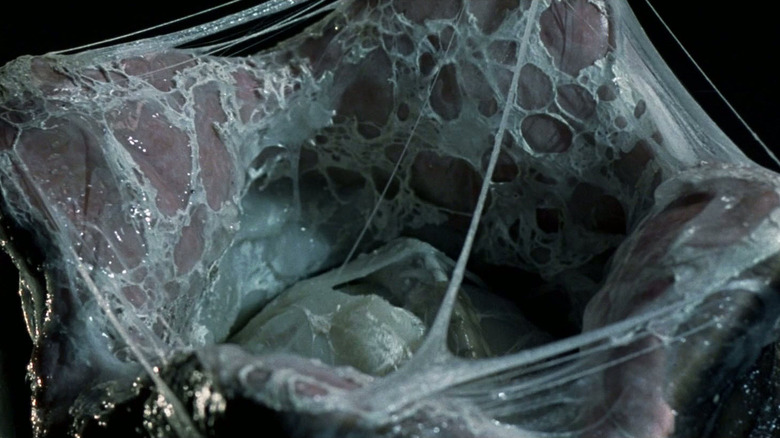Alien's Facehugger Props Were Somehow Even Grosser Than They Look
The title of Ridley Scott's 1979 "Alien" is both a noun and an adjective. Yes, it is about a crew of space-bound freight haulers who unwittingly bring aboard a terrifying, murderous creature made of bones, teeth, sex organs, and aspic. But it is also about how utterly alien the creature is — and how the humans aren't equipped to face off against its biological idiosyncrasies. It helped that the creature was designed by Swiss surrealist H.R. Giger, already known in the art world for his off-putting, shadowy biomechanics. The creature was specifically inspired by his 1976 painting "Necronom IV."
Since "Alien," there have been seven sequels/prequels/crossover films, a toy line, and goodness knows how many comic books to explore the creature's mysteries. Even casual observers now know it reproduces via a smaller, buglike "facehugger" that implants an "egg" in the chests of its hosts. When the egg hatches, the infant creature bursts out of its host's chest, killing them. The creature then grows to the size of an adult human within its first day of life. From the rate of its growth, it might have been safe to assume the creatures absorb nutrients from its host, don't eat, then starve to death within a few days. That theory would be contradicted by later sequels, which show alien queens, intelligent monsters, and beasties that are years old. It was referred to as "Xenomorph XX121" in James Cameron's 1986 sequel, "Aliens," and fans took the word "Xenomorph" as the monster's official moniker.
But there was a time when the mystery was still intact, and the facehugger was the most terrifying aspect of the alien. Looking like an elongated horseshoe crab crossed with a pus-colored cockroach, the facehugger attached itself to John Hurt's character's head and forced him into a coma while slowly impregnating him through his mouth. The sexual assault symbolism was intentional. The facehugger burst forth from a leathery, 2-foot egg, and Hurt had a gloriously terrifying moment leaning over an open egg to fathom the moving glop inside. The means to create the facehugger and the egg are pretty gross.
What tripe
Cast and crew members laid out special effects techniques they used during the film's production in the commentary track for "Alien" when the film's director's cut was first released on DVD in 2003.
In order to achieve the icky, organic look of the facehugger, Ridley Scott employed some actual organic compounds. The egg would open via a series of metal, mechanical servos, but inside the egg was a slurry of amniotic esoterica made of actual animal entrails. Scott extended his own gloved hands into the egg from an aperture beneath and would wiggle his fingers to make the viscera look alive.
The facehugger itself was initially intended to be a sickly green color, but screenwriter Dan O'Bannon was able to sneak a peek of the creature model while it was still being built and preferred the bone color. This seemed like a wise choice. The creature was coated in slime, a common ingredient in "Alien" films. It's a well-worn piece of trivia that star Sigourney Weaver suffered allergy attacks on the set of "Alien," suspecting the cat as the culprit. She later learned it was not the cat, but the glycerin compound sprayed on her face to simulate sweat. Slimes and sprays and compounds were everywhere on the monsters. According to Tom Woodruff Jr., who played the alien in David Fincher's "Alien 3," the slime dripping down the creature was the same material used to thicken milkshakes at fast food restaurants.
Intestines too
The facehugger itself was also made of some actual organic compounds. The long tail — the one that wraps itself around John Hurt's neck — was constructed using a cow intestine, and the tail's rapid whipping about was achieved by blowing air through it. Yes, that is an actual flailing gut.
Later in the film, the facehugger drops off John Hurt's face and falls to the floor, seemingly dead. In order to learn more, Ash (Ian Holm) suspiciously dissects it, being very careful as the creature bleeds a powerful acid that can eat through the hull of the ship. The shell of the facehugger was only a plastic mold, but its innards were real. Holm was poking a scalpel through several raw oysters.
These meaty effects made for a creature more realistic — and more alien — than had been seen in sci-fi cinema up to that point, and Giger's design of the final alien, eventually played by Bolaji Badejo, has since made its way into cinema history as one of the best of all movie monsters. It just goes to show that if you want a truly remarkable creature, you have to be willing to get your hands dirty.


